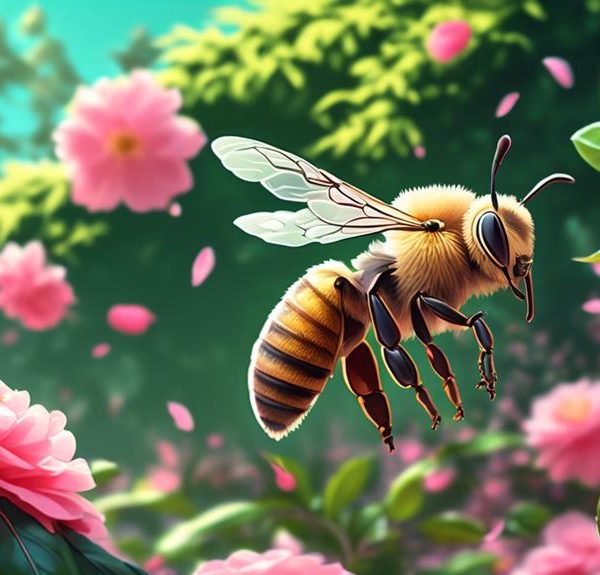Amidst the vibrant world of flowers and bees, does the allure of calla lilies captivate these buzzing pollinators? Discover the surprising answer.
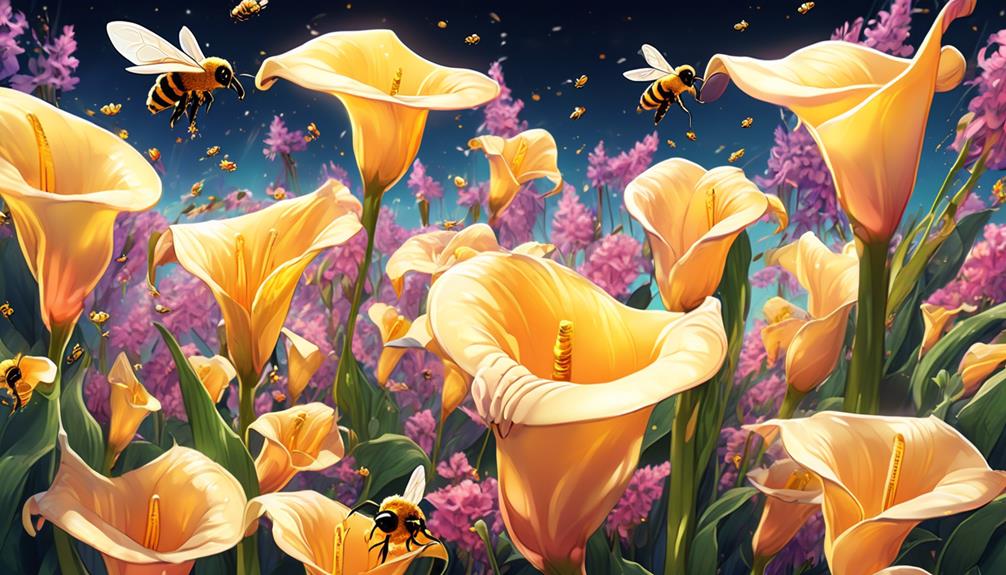
Do Bees Like Calla Lilies
Much like the famous phrase 'bees to honey,' you might wonder if the same attraction exists between bees and the elegant calla lilies. As a garden enthusiast or a nature lover, you're aware that certain flowers hold a special allure to these buzzing pollinators, but do calla lilies make the list?
The answer might not be as straightforward as you'd think. While bees are known for their attraction to brightly colored, fragrant flowers, the preference can vary depending on the species, location, and available resources.
As you explore this fascinating intersection of botany and entomology, you may want to strap on your gardening gloves and prepare to be surprised.
Key Takeaways
- Bees are attracted to calla lilies due to their vibrant colors, unique shapes, and sweet nectar.
- Calla lilies rely on bees for fertilization and reproduction, as bees inadvertently transfer pollen from calla lilies to other flowers.
- Planting calla lilies in clusters, providing a water source, avoiding pesticides, and planting different varieties that bloom at different times can attract more bees.
- The relationship between bees and calla lilies is an ecological partnership that benefits both parties and contributes to plant reproduction.
Understanding Bees' Flower Preferences
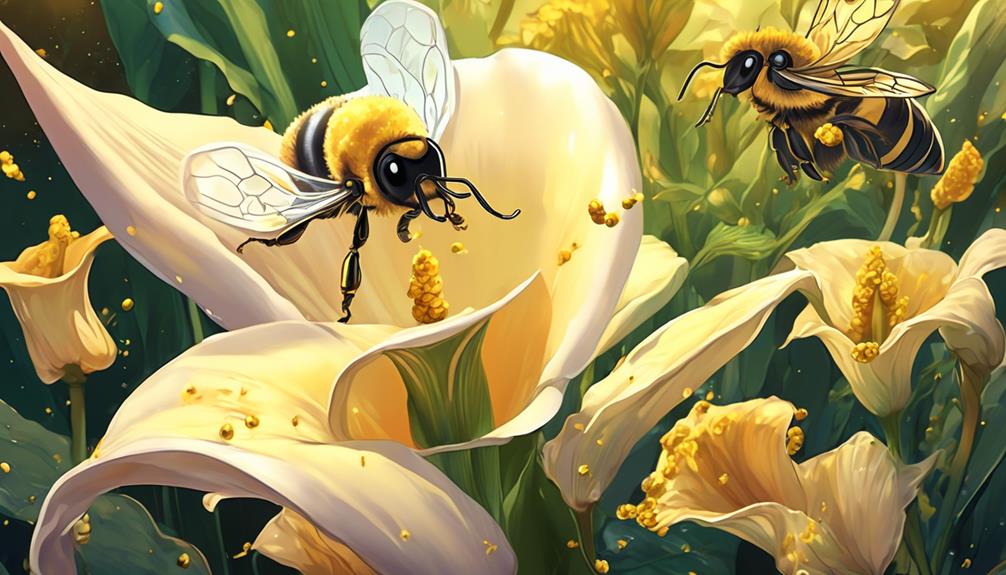
Often, bees exhibit clear preferences for certain flowers, such as calla lilies, based on factors like color, shape, and nectar production. This pattern isn't random. It's rooted in the science of bees' survival, reproduction, and the mutualistic relationship they've forged with flowers over millions of years.
You might wonder, why do bees prefer certain flowers over others? It's a matter of efficiency and reward. The color and shape of a flower can signal to a bee that it's a good source of nectar and pollen, the bee's primary food sources. For instance, bees are more attracted to blue, purple, yellow, and white flowers, and they prefer flowers with a radial pattern, like calla lilies.
Nectar production also matters. Flowers that produce a lot of nectar, like calla lilies, are like all-you-can-eat buffets for bees. The bees get a good meal, and in return, they pollinate the flowers, helping them reproduce.
Calla Lilies: An Overview
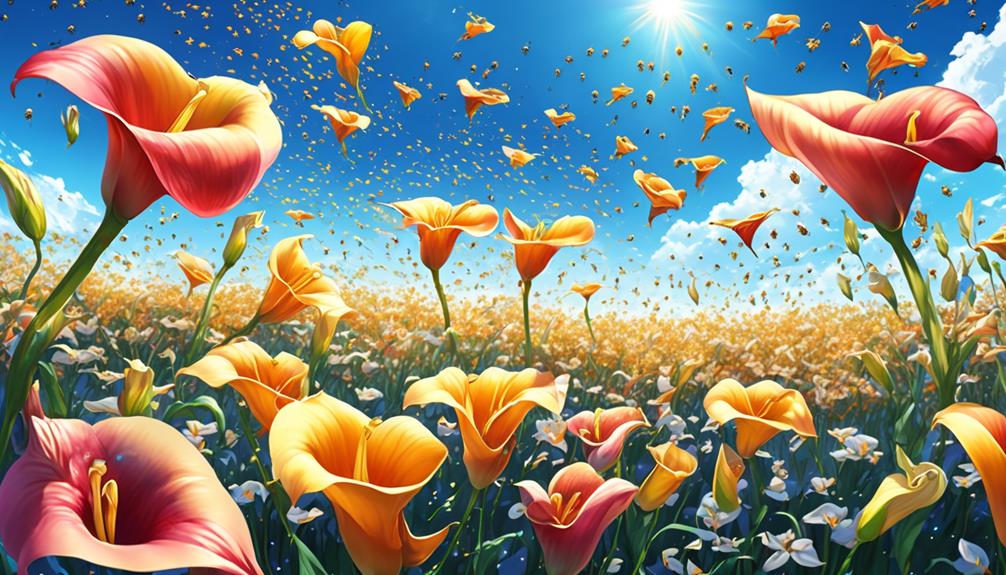
Delving into the world of calla lilies, you'll find that these radiant, trumpet-shaped flowers, native to South Africa, aren't only aesthetically pleasing but also highly attractive to bees due to their unique characteristics.
Calla lilies belong to the Araceae family, with the scientific name Zantedeschia aethiopica. They're perennials that thrive in well-draining soil, full sun or partial shade. Though they're often associated with funerals and purity due to their pristine white color, they also come in hues of pink, yellow, and even a deep, rich purple.
Their distinct spathe (the large, showy bract that encapsulates the spadix) serves as a landing platform for bees. This unique architectural design, coupled with their large pollen-rich spadix, attracts bees and facilitates their pollination process.
Calla lilies bloom in late spring to early summer, providing a food source for bees during these seasons. Their nectar, rich in sucrose, glucose, and fructose, is a high-energy food source that bees can't resist.
The Role of Flowers in Bees' Lives
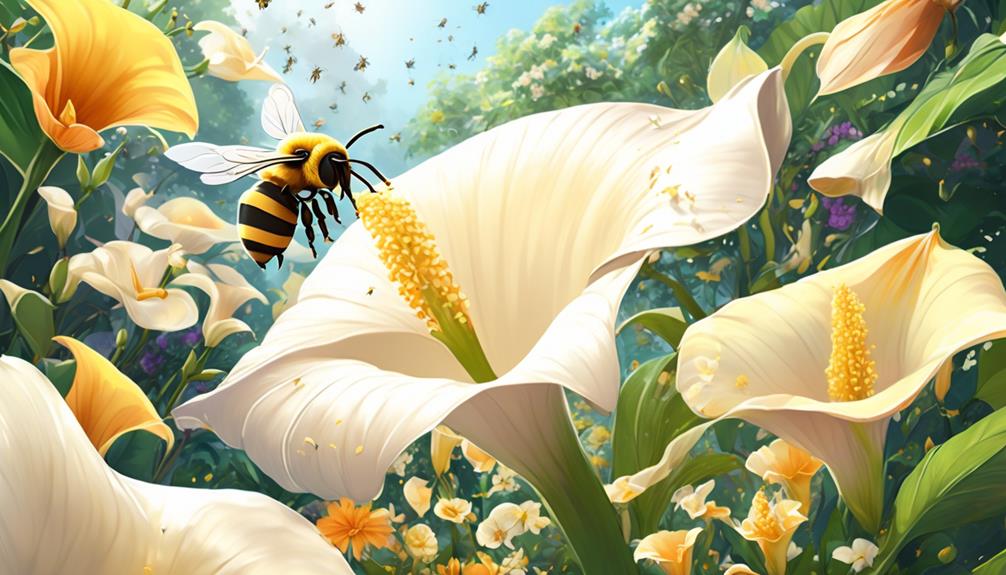
While calla lilies and their irresistible nectar play a vital role in nourishing bees, it's crucial to understand the broader significance of flowers in the lives of these industrious insects.
Flowers are a bee's bread and butter, literally. They offer a rich source of two essential nutrients: nectar, which provides energy, and pollen, which offers protein and fats crucial for bee growth and development. As a bee flutters from flower to flower, it's not simply indulging in a sweet feast. It's carrying out an essential survival task, storing nectar and pollen to take back to the hive.
But there's more to this relationship than meets the eye. You see, as a bee visits a flower, it inadvertently picks up pollen on its body, which then rubs off onto the next flower it visits. This process, called pollination, is essential for the reproduction of many plant species, including our food crops.
Bees and Calla Lilies: A Relationship

In your own backyard, you'll regularly observe bees buzzing around your calla lilies, attracted by the rich nectar these flowers produce. This interaction isn't just a coincidence, but a symbiotic relationship that's been evolving for millions of years.
Calla lilies, like other flowers, rely on pollinators such as bees for fertilization. They lure bees with their vibrant colors, unique shapes, and the promise of sweet nectar. Once a bee lands on the calla lily, it's greeted with pollen, which sticks to its body. As the bee moves from flower to flower, it inadvertently transfers this pollen, allowing the lilies to reproduce.
However, bees obtain more than just nectar from this relationship. The pollen they collect serves as a vital food source, rich in proteins and fats that are essential for their growth and development. Therefore, calla lilies aren't just a feeding station for bees, but an integral part of their survival. In return, bees play a crucial role in the propagation of calla lilies.
Thus, the relationship between bees and calla lilies is more than an attraction; it's an ecological partnership that's crucial for both parties' survival.
Attracting Bees With Your Calla Lilies

Having understood the mutual dependence between bees and calla lilies, you might be interested in how to maximize this interaction in your own garden. Cultivating a garden that's attractive to bees will not only aid in the pollination of your calla lilies but also contribute to the well-being of local bee populations.
Here are some specific strategies you can employ:
Strategy | Description |
|---|---|
Planting | Plant your calla lilies in clusters to make them more visible to bees. |
Watering | Provide a water source. Bees need it to drink and to cool their hives. |
Pesticiding | Avoid using pesticides. They can be harmful or deadly to bees. |
Timing | Plant lilies that bloom at different times to provide bees with a constant food source. |
Diversifying | Mix in other bee-attracting plants. This increases the overall attraction of your garden to bees. |
Impact on Ecosystem: Bees and Calla Lilies Interaction
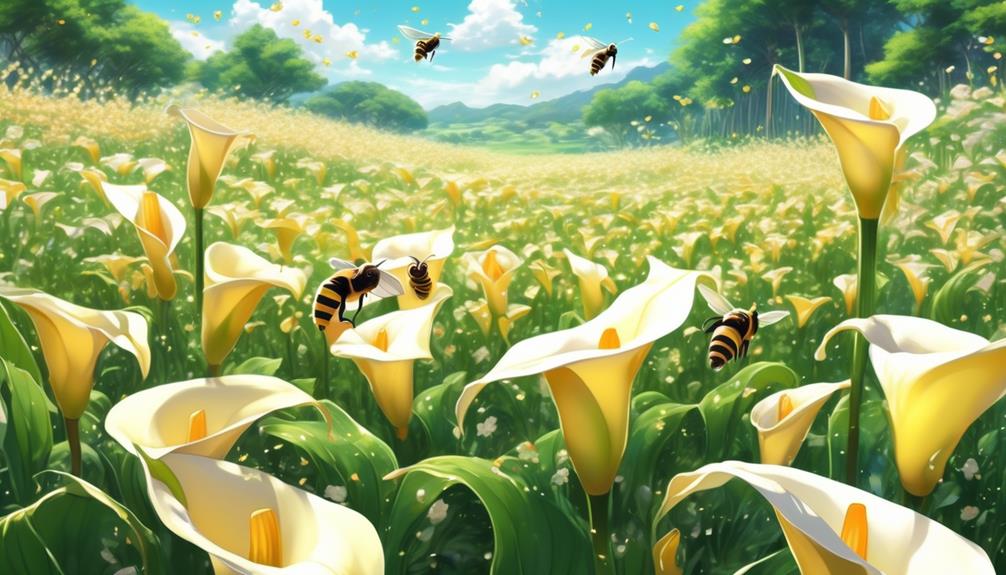
Through the interaction of bees and calla lilies, you're not only enriching your garden but also significantly contributing to the overall health and diversity of your local ecosystem. This biotic interaction forms a crucial part of the complex web of life that underpins ecological balance.
Bees, as primary pollinators, facilitate plant reproduction by transferring pollen from the male structures of a flower to the female ones. In the case of calla lilies, their large, showy spathes attract bees, and the enclosed spadix produces heat, aiding in the release of attractive scents. This lures bees into the flower, where they inadvertently pick up pollen.
This exchange is mutually beneficial. While the bee gets nectar, a vital food source, the calla lily gets pollinated, ensuring its propagation. This interaction thus bolsters the local biodiversity, encouraging a more robust and resilient ecosystem.
Moreover, the presence of calla lilies in your garden enhances the habitat for bees, offering them a reliable source of nutrition. You're indirectly aiding in the conservation of bee populations which have been facing significant declines globally. Consequently, your garden becomes a small yet significant haven for these vital pollinators, reinforcing the intricate symbiosis that sustains our ecosystems.
Frequently Asked Questions
Can Bees Be Harmful to Calla Lilies?
No, bees aren't harmful to calla lilies. In fact, they're beneficial. Bees help in pollination, which is crucial for the reproduction of many plants, including calla lilies.
When a bee lands on a flower, pollen sticks to its body. As it moves to the next flower, some pollen rubs off, fertilizing the plant.
What Other Insects Are Attracted to Calla Lilies?
You're likely to notice various insects attracted to Calla lilies. Besides bees, these flowers also allure butterflies and beetles. The bright colors and unique shape of the lilies serve as a beacon for these insects. They're attracted to the nectar and pollen, which provide essential nutrients.
However, you might also spot some unwanted pests like aphids, spider mites, and thrips. These creatures can harm your lilies, so it's important to keep an eye out for them.
How Can We Protect Bees While Also Ensuring They Pollinate Calla Lilies?
You can protect bees and encourage them to pollinate Calla Lilies by minimizing pesticide use. Instead, try organic pest control methods.
Plant a variety of flowers to provide bees with nectar and pollen throughout the year. Also, providing a bee-friendly habitat with fresh water and shelter can help.
Do Bees Prefer Calla Lilies Over Other Flowers in a Garden?
You've asked if bees prefer calla lilies over other flowers. While bees are attracted to calla lilies, they don't necessarily prefer them over other blooms.
Bees are opportunistic and will visit a variety of flowers in search of nectar and pollen. They're drawn to colorful, fragrant flowers, and calla lilies fit that description. However, bees don't discriminate and will visit any flowers that provide the resources they need.
What Are the Effects of Climate Change on the Interaction Between Bees and Calla Lilies?
Climate change can indeed affect your bees' interaction with calla lilies. As temperatures rise, bees may alter their foraging schedules, which can impact when they visit these flowers.
Unpredictable weather patterns can also disrupt the blooming period of calla lilies, causing a mismatch in timing. This means bees may not find the nectar they need when they're active, which can harm both the pollinators and the plants.
Conclusion
So, do bees like calla lilies?
Absolutely! Calla lilies offer bees a rich source of nectar, and in return, bees help with their pollination.
By planting these beautiful flowers, you're not only enhancing your garden's beauty, but you're also playing a significant role in supporting our vital bee populations.
So, go ahead, let your garden buzz with life and contribute to a healthier ecosystem with your calla lilies!


